The NVIDIA GeForce GTX Titan X Review
by Ryan Smith on March 17, 2015 3:00 PM ESTPower, Temperature, & Noise
As always, last but not least is our look at power, temperature, and noise. Next to price and performance of course, these are some of the most important aspects of a GPU, due in large part to the impact of noise. All things considered, a loud card is undesirable unless there’s a sufficiently good reason – or sufficiently good performance – to ignore the noise.
The GTX Titan X represents a very interesting intersection for NVIDIA, crossing Maxwell’s unparalleled power efficiency with GTX Titan’s flagship level performance goals and similarly high power allowance. The end result is that this gives us a chance to see how well Maxwell holds up when pushed to the limit; to see how well the architecture holds up in the form of a 601mm2 GPU with a 250W TDP.
| GeForce GTX Titan X Voltages | ||||
| GTX Titan X Boost Voltage | GTX 980 Boost Voltage | GTX Titan X Idle Voltage | ||
| 1.162v | 1.225v | 0.849v | ||
Starting off with voltages, based on our samples we find that NVIDIA has been rather conservative in their voltage allowance, presumably to keep power consumption down. With the highest stock boost bin hitting a voltage of just 1.162v, GTX Titan X operates notably lower on the voltage curve than the GTX 980. This goes hand-in-hand with GTX Titan X’s stock clockspeeds, which are around 100MHz lower than GTX 980.
| GeForce GTX Titan X Average Clockspeeds | |||
| Game | GTX Titan X | GTX 980 | |
| Max Boost Clock | 1215MHz | 1252MHz | |
| Battlefield 4 |
1088MHz
|
1227MHz
|
|
| Crysis 3 |
1113MHz
|
1177MHz
|
|
| Mordor |
1126MHz
|
1164MHz
|
|
| Civilization: BE |
1088MHz
|
1215MHz
|
|
| Dragon Age |
1189MHz
|
1215MHz
|
|
| Talos Principle |
1126MHz
|
1215MHz
|
|
| Far Cry 4 |
1101MHz
|
1164MHz
|
|
| Total War: Attila |
1088MHz
|
1177MHz
|
|
| GRID Autosport |
1151MHz
|
1190MHz
|
|
Speaking of clockspeeds, taking a look at our average clockspeeds for GTX Titan X and GTX 980 showcases just why the 50% larger GM200 GPU only leads to an average performance advantage of 35% for the GTX Titan X. While the max boost bins are both over 1.2GHz, the GTX Titan has to back off far more often to stay within its power and thermal limits. The final clockspeed difference between the two cards depends on the game in question, but we’re looking at a real-world clockspeed deficit of 50-100MHz for GTX Titan X.
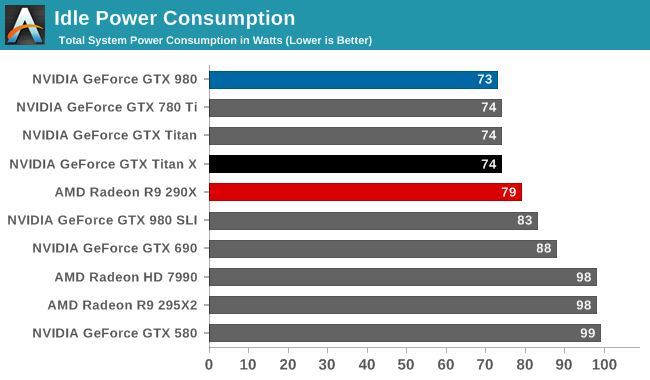
Starting off with idle power consumption, the GTX Titan X comes out strong as expected. Even at 8 billion transistors, NVIDIA is able to keep power consumption at idle very low, with all of our recent single-GPU NVIDIA cards coming in at 73-74W at the wall.
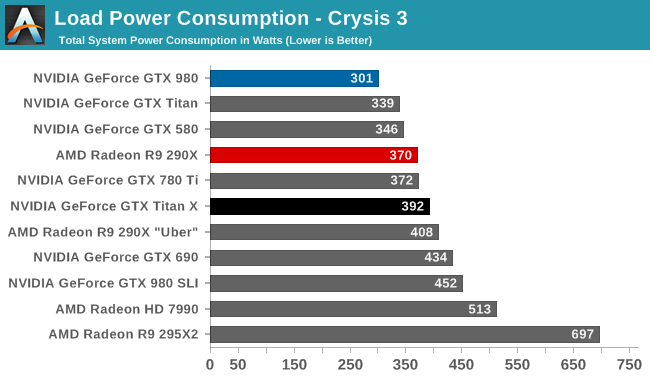
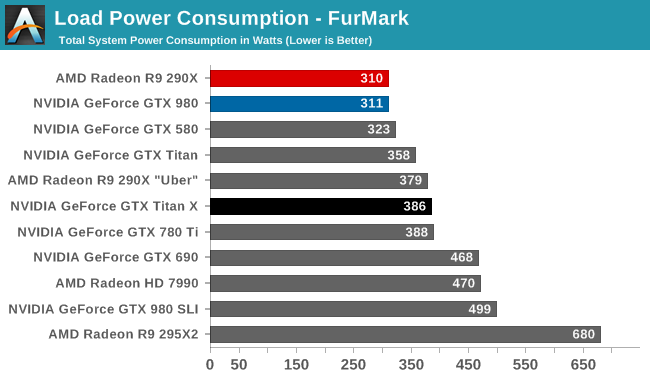
Meanwhile load power consumption for GTX Titan X is more or less exactly what we’d expect. With NVIDIA having nailed down their throttling mechanisms for Kepler and Maxwell, the GTX Titan X has a load power profile almost identical to the GTX 780 Ti, the closest equivalent GK110 card. Under Crysis 3 this manifests itself as a 20W increase in power consumption at the wall – generally attributable to the greater CPU load from GTX Titan X’s better GPU performance – while under FurMark the two cards are within 2W of each other.
Compared to the GTX 980 on the other hand, this is of course a sizable increase in power consumption. With a TDP difference on paper of 85W, the difference at the wall is an almost perfect match. GTX Titan X still offers Maxwell’s overall energy efficiency, delivering greatly superior performance for the power consumption, but this is a 250W card and it shows. Meanwhile the GTX Titan X’s power consumption also ends up being very close to the unrestricted R9 290X Uber, which in light of the Titan’s 44% 4K performance advantage further drives home the point about NVIDIA’s power efficiency lead at this time.
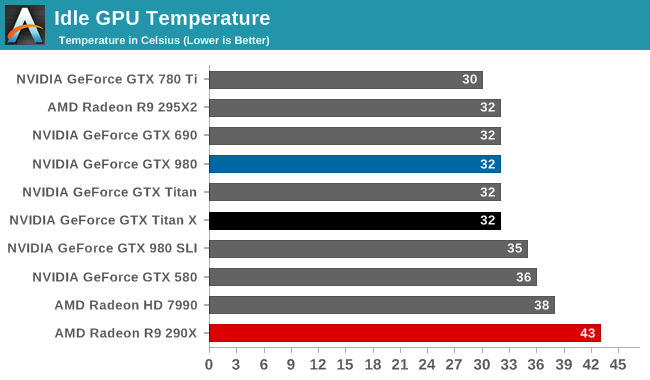
With the same Titan cooler and same idle power consumption, it should come as no surprise that the GTX Titan X offers the same idle temperatures as its GK110 predecessors: a relatively cool 32C.
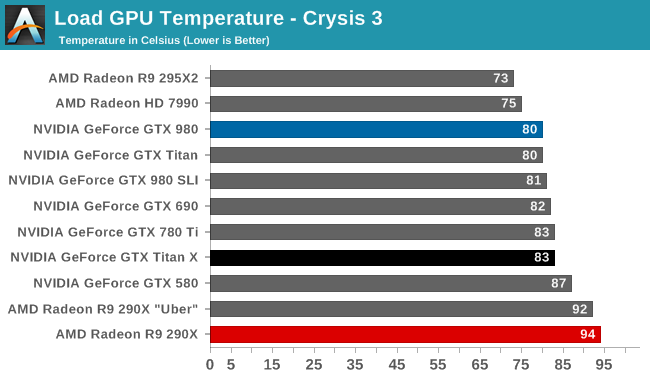

Moving on to load temperatures, the GTX Titan X has a stock temperature limit of 83C, just like the GTX 780 Ti. Consequently this is exactly where we see the card top out at under both FurMark and Crysis 3. 83C does lead to the card temperature throttling in most cases, though as we’ve seen in our look at average clockspeeds it’s generally not a big drop.

Last but not least we have our noise results. With the Titan cooler backing it, the GTX Titan X has no problem keeping quiet at idle. At 37.0db(A) it's technically the quietest card among our entire collection of high-end cards, and from a practical perspective is close to silent.
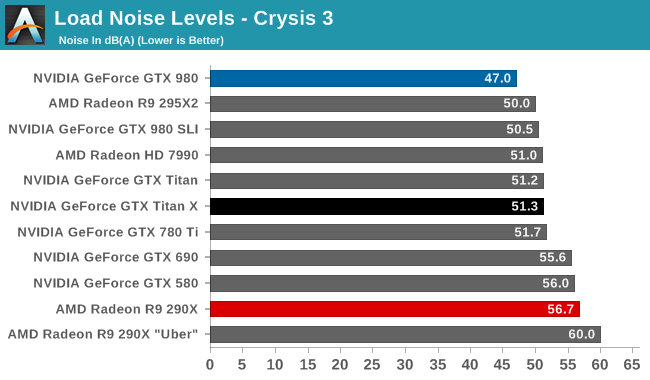
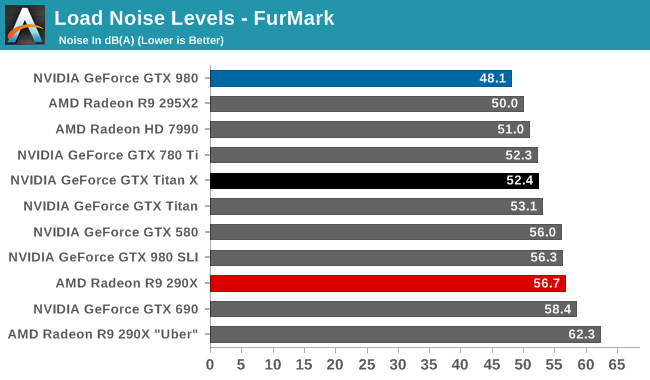
Much like GTX Titan X’s power profile, GTX Titan X’s noise profile almost perfectly mirrors the GTX 780 Ti. With the card hitting 51.3dB(A) under Crysis 3 and 52.4dB(A) under FurMark, it is respectively only 0.4dB and 0.1dB off from the GTX 780 Ti. From a practical perspective what this means is that the GTX Titan X isn’t quite the hushed card that was the GTX 980 – nor with a 250W TDP would we expect it to be – but for its chart-topping gaming performance it delivers some very impressive acoustics. The Titan cooler continues to serve NVIDIA well, allowing them to dissipate 250W in a blower without making a lot of noise in the process.
Overall then, from a power/temp/noise perspective the GTX Titan X is every bit as impressive as the original GTX Titan and its GTX 780 Ti sibling. Thanks to the Maxwell architecture and Titan cooler, NVIDIA has been able to deliver a 50% increase in gaming performance over the GTX 780 Ti without an increase in power consumption or noise, leading to NVIDIA once again delivering a flagship video card that can top the performance charts without unnecessarily sacrificing power consumption or noise.










276 Comments
View All Comments
looncraz - Tuesday, March 17, 2015 - link
If the most recent slides (allegedly leaked from AMD) hold true, the 390x will be at least as fast as the Titan X, though with only 8GB of RAM (but HBM!).A straight 4096SP GCN 1.2/3 GPU would be a close match-up already, but any other improvements made along the way will potentially give the 390X a fairly healthy launch-day lead.
I think nVidia wanted to keep AMD in the dark as much as possible so that they could not position themselves to take more advantage of this, but AMD decided to hold out, apparently, until May/June (even though they apparently already have some inventory on hand) rather than give nVidia a chance to revise the Titan X before launch.
nVidia blinked, it seems, after it became apparent AMD was just going to wait out the clock with their current inventory.
zepi - Wednesday, March 18, 2015 - link
Unless AMD has achieved considerable increase in perf/w, they are going to have really hard time tuning those 4k shaders to a reasonable frequency without being a 450W card.Not that being a 500W is necessarily a deal breaker for everyone, but in practice cooling a 450W card without causing ear shattering level of noise is very difficult compared to cooling a 250W card.
Let us wait and hope, since AMD really would need to get a break and make some money on this one...
looncraz - Wednesday, March 18, 2015 - link
Very true. We know that with HBM there should already be a fairly beefy power savings (~20-30W vs 290X it seems).That doesn't buy them room for 1,280 more SPs, of course, but it should get them a healthy 256 of them. Then, GCN 1.3 vs 1.1 should have power advantages as well. GCN 1.2 vs 1.0 (R9 285 vs R9 280) with 1792 SPs showed a 60W improvement, if we assume GCN 1.1 to GCN 1.3 shows a similar trend the 390X should be pulling only about 15W more than the 290X with the rumored specs without any other improvements.
Of course, the same math says the 290X should be drawing 350W, but that's because it assumes all the power is in the SPs... But I do think it reveals that AMD could possibly do it without drawing much, if any, more power without making any unprecedented improvements.
Braincruser - Wednesday, March 18, 2015 - link
Yeah, but the question is, How well will the memory survive on top of a 300W GPU?Because the first part in a graphic card to die from high temperatures is the VRAM.
looncraz - Thursday, March 19, 2015 - link
It will be to the side, on a 2.5d interposer, I believe.GPU thermal energy will move through the path of least resistance (technically, to the area with the greatest deltaT, but regulated by the material thermal conductivity coefficient), which should be into the heatsink or water block. I'm not sure, but I'd think the chips could operate in the same temperature range as the GPU, but maybe not. It may be necessary to keep them thermally isolated. Which shouldn't be too difficult, maybe as simple as not using thermal pads at all for the memory and allowing them to passively dissipate heat (or through interposer mounted heatsinks).
It will be interesting to see what they have done to solve the potential issues, that's for sure.
Xenonite - Thursday, March 19, 2015 - link
Yes, I agree that AMD would be able to absolutely destroy NVIDIA on the performance front if they designed a 500W GPU and left the PCB and waterblock design to their AIB partners.I would also absolutely love to see what kind of performance a 500W or even a 1kW graphics card would be able to muster; however, since a relatively constant 60fps presented with less than about 100ms of total system latency has been deemed sufficient for a "smooth and responsive" gaming experience, I simply can't imagine such a card ever seeing the light of day.
And while I can understand everyone likes to pretend that they are saving the planet with their <150W GPUs, the argument that such a TDP would be very difficult to cool does not really hold much water IMHO.
If, for instance, the card was designed from the ground up to dissipate its heat load over multiple 200W~300W GPUs, connected via a very-high-speed, N-directional data interconnect bus, the card could easily and (most importantly) quietly be cooled with chilled-watercooling dissipating into a few "quad-fan" radiators. Practically, 4 GM200-size GPUs could be placed back-to-back on the PCB, with each one rendering a quarter of the current frame via shared, high-speed frame buffers (thereby eliminating SLI-induced microstutter and "frame-pacing" lag). Cooling would then be as simple as installing 4 standard gpu-watercooling loops with each loop's radiator only having to dissipate the TDP of a single GPU module.
naxeem - Tuesday, March 24, 2015 - link
They did solve that problem with a water-cooling solution. 390X WCE is probably what we'll get.ShieTar - Wednesday, March 18, 2015 - link
Who says they don't allow it? EVGA have already anounced two special models, a superclocked one and one with a watercooling-block:http://eu.evga.com/articles/00918/EVGA-GeForce-GTX...
Wreckage - Tuesday, March 17, 2015 - link
If by fast you mean June or July. I'm more interested in a 980ti so I don't need a new power supply.ArmedandDangerous - Saturday, March 21, 2015 - link
There won't ever be a 980 Ti if you understand Nvidia's naming schemes. Ti's are for unlocked parts, there's nothing to further unlock on the 980 GM204.